My Trip to the Met
George Grey Barnard (1863-1938)
"Struggle between the Two Natures of Man"
It's inconvenient and expensive -- but yes, it is possible to take a day trip to the Met when you live in Chicago. You just have to wake up at 2:30 am.
So here's a record of a weekend stroll through some of the galleries.
******************
We arrived just as the museum was opening -- and having skipped breakfast, made a beeline to the food service area in the American Wing, the only one open at that hour.
Which gave me a good opportunity to contemplate the above statue, modeled in Paris when the artist was 25, and carved 5 years later.
What a great piece! I can understand why Barnard became an overnight sensation in the Age of Rodin.
(note: as recorded seven years ago, I wasn't so enchanted by this piece on earlier visits -- but still was fascinated by the artist who did a remarkable public statue in Cincinnati)
Here's what he had to say about it (originally entitled "The Victor") :
“I shall try and bring all the anguish that what we call a victor is susceptible to-that is the higher one gets the more delicate he is strung-and all the winds of life strike on him….”
Wonderfully composed in whole as well as areas of detail, it's quite naturalistic, as well as idealistic -- and it's ideals are outside any traditional religious or mythological narrative.
What a sweet face for Man's dreamy better nature.
His lesser nature is handsome also
but perhaps more self centered - and practical.
Man's better nature is Greek -- his lesser nature is Roman.
but perhaps more self centered - and practical.
Man's better nature is Greek -- his lesser nature is Roman.
An insane complexity runs across these shoulders.
I'm guessing that many cups of coffee
were consumed during its design.
were consumed during its design.
Unlike Rodin's sculptures, these figures, though still flesh and bone, are rising above their fleshiness. What a fine American ideal ! But unfortunately, this seems to have been the highlight of Barnard's career. Hopefully, I'll eventually see his group ensemble in Philadelphia, but in reproductions it looks cluttered.
Masseo Civitali, 1493
The name of this late 15th C. Luccan sculptor is so obscure, he might even be considered an "outsider" or folk artist. This is the only piece by him that Google can find.
But like the best folk art, this piece really has feeling
-- and outsider artists always do their best
when angels or devils are the subject matter.
How sweet!
How heart felt!
So much historical art feels competent but not especially inspired.
Which is why this piece stands out - even in a room filled with work by more famous names.
Choir Screen depicting the arrest of Jesus
Amiens Cathedral, 1264-85
Now we've entered the great hall of Gothic sculpture.
Nearly 50 years ago, I spent an entire Summer in Manhattan,
mostly wandering through the Met
drawing sculptures like this one.
(it's always been one of my favorites)
What a great period this was
for European sculpture!
Tomb effigy, 1450-1460
Here's another great French sculpture
though it's original location is only conjectural.
It feels more severe than the scene from Amiens,
appropriate for a life of reclusive scholarship.
I wonder if the sculptor had ever met his subject.
The above makes a nice comparison with this portrait of a monk
done by the great medieval Japanese sculptor, Ukei (1150-1223)
Austria, 1390
Here's another sweet Annunciation.
Why not call it folk art?
I suppose because you can sense the architectural setting
that once surrounded it,
just as you could feel the big band
even when Anita O'day was singing without one.
I love a pudgy face.
Champagne, 1300-1320
I was a bit surprised
at how few pieces I really liked
in the Met's enormous hall of Medieval sculpture.
It's not that the stuff was terrible,
it's just that it did not rise that far
above its narrative function.
But the above piece,
damaged though it is,
made the cut.
There's that wonderful swing.
And the sizes of parts
seem so perfectly chosen.
It reminds me of the sculpture on Rheims Cathedral.
There's a feeling that the most massive possible forces
have resolved themselves into
the softest, most gentle folds.
Workshop of Veit Stoss, 1480-90
Too bad the man who carved this
never made his own name famous.
It's not quite as rambunctious
as the work of his boss, shown below.
Veit Stoss, detail from the Krakow altarpiece
Carrier-Belleuse, 1870
We now headed off to the special Balthus exhibit
(which I write about here )
Our path took us through the galleries
of European sculpture and Decorative Arts.
This piece caught my attention,
but perhaps that's only because
I collect images of Leda and the Swan.
This piece is much more satisfying in detail
Antoine-Augustin Préault, 1866
I'm not going to accuse this of being great sculpture,
but it's just the kind of thing
one hopes to find in a 19th C. cemetery.
(a cast of this one was once in Montmarte)
The actor being depicted as 'Hamlet"
was Philibert Rouviere,
who was also depicted in that role by Edouard Manet.
as seen in this recent show at the University of Chicago.
Obviously, Rouviere was the talk of the town.
Rodin, portrait of Pierre Puvis de Chavannes, c. 1890
Leaving the special exhibition area,
we stroll down a magnificent hallway
decked out with late 19th C. French painting and sculpture.
What a wonderful wrinkly old eye.
Again, the special joy
is the contrast
of the large with the tiny..
It feels like the eye of a great painter.
Our next destination were the galleries of Islamic art,
a fabulous museum-within-a-museum
of the kind of things that never make it to Chicago.
( this sad situation is discussed here )
I took lots of photographs, but none of them are as good
as what the Met has put up on its own website.
The above Mughal painting can be found
here
Muzaffar 'Ali
There are many nice carpets, glass jars, and paintings
in these galleries,
but the highlight has to be the Arthur A. Houghton Jr.
collection of early 16th C. miniatures from Tabriz,
created, one assumes, under the royal patronage
of Shah Tahmasp I. (1514-1576)
Houghten's patronage of the arts,
including his own glass factory, Steuben Glass,
was almost equal to that of the Safavid Shah's.
Qasim ibn 'Ali
Aqa Mirak
Qasim ibn 'Ali
Qadimi
Sultan Muhammad

Qasim ibn 'Ali
I'm guessing that the Houghton collection
rotates through these display cases several times every year --
a good reason to visit New York much more often!
Hans Memling, 1480
After lunch at the new Met Cafeteria
(which is, by the way, far better than the old one)
we wandered over to the nearby Lehman Wing,
where the above piece caught my fancy.
If this were blown up to life size,
it would resemble an Alex Katz painting ,
except that it feels so much deeper.
I've been reading some books about modern portraiture lately.
Does the above express the inner life of its subject
any less than Kokoshka did in his portraits?
Sassetta, 1435
I love angels -- and this one is so other-worldly.
Constantinople, 630
We came across a glass case full of treasures,
the Second Cyprus teasures to be exact,
while returning to exit the front door of the museum.
Again, the museum's web site offers much better images than my camera can produce.
Now we've entered the great hall of Gothic sculpture.
Nearly 50 years ago, I spent an entire Summer in Manhattan,
mostly wandering through the Met
drawing sculptures like this one.
(it's always been one of my favorites)
What a great period this was
for European sculpture!
Tomb effigy, 1450-1460
Here's another great French sculpture
though it's original location is only conjectural.
It feels more severe than the scene from Amiens,
appropriate for a life of reclusive scholarship.
I wonder if the sculptor had ever met his subject.
The above makes a nice comparison with this portrait of a monk
done by the great medieval Japanese sculptor, Ukei (1150-1223)
Austria, 1390
Here's another sweet Annunciation.
Why not call it folk art?
I suppose because you can sense the architectural setting
that once surrounded it,
just as you could feel the big band
even when Anita O'day was singing without one.
I love a pudgy face.
Champagne, 1300-1320
I was a bit surprised
at how few pieces I really liked
in the Met's enormous hall of Medieval sculpture.
It's not that the stuff was terrible,
it's just that it did not rise that far
above its narrative function.
But the above piece,
damaged though it is,
made the cut.
There's that wonderful swing.
And the sizes of parts
seem so perfectly chosen.
It reminds me of the sculpture on Rheims Cathedral.
There's a feeling that the most massive possible forces
have resolved themselves into
the softest, most gentle folds.
Workshop of Veit Stoss, 1480-90
Too bad the man who carved this
never made his own name famous.
It's not quite as rambunctious
as the work of his boss, shown below.
Veit Stoss, detail from the Krakow altarpiece
Carrier-Belleuse, 1870
We now headed off to the special Balthus exhibit
(which I write about here )
Our path took us through the galleries
of European sculpture and Decorative Arts.
This piece caught my attention,
but perhaps that's only because
I collect images of Leda and the Swan.
This piece is much more satisfying in detail
Antoine-Augustin Préault, 1866
I'm not going to accuse this of being great sculpture,
but it's just the kind of thing
one hopes to find in a 19th C. cemetery.
(a cast of this one was once in Montmarte)
The actor being depicted as 'Hamlet"
was Philibert Rouviere,
who was also depicted in that role by Edouard Manet.
as seen in this recent show at the University of Chicago.
Obviously, Rouviere was the talk of the town.
Rodin, portrait of Pierre Puvis de Chavannes, c. 1890
Leaving the special exhibition area,
we stroll down a magnificent hallway
decked out with late 19th C. French painting and sculpture.
What a wonderful wrinkly old eye.
Again, the special joy
is the contrast
of the large with the tiny..
It feels like the eye of a great painter.
Our next destination were the galleries of Islamic art,
a fabulous museum-within-a-museum
of the kind of things that never make it to Chicago.
( this sad situation is discussed here )
I took lots of photographs, but none of them are as good
as what the Met has put up on its own website.
The above Mughal painting can be found
here
Muzaffar 'Ali
There are many nice carpets, glass jars, and paintings
in these galleries,
but the highlight has to be the Arthur A. Houghton Jr.
collection of early 16th C. miniatures from Tabriz,
created, one assumes, under the royal patronage
of Shah Tahmasp I. (1514-1576)
Houghten's patronage of the arts,
including his own glass factory, Steuben Glass,
was almost equal to that of the Safavid Shah's.
Qasim ibn 'Ali
Aqa Mirak
Qasim ibn 'Ali
Qadimi
Sultan Muhammad

Qasim ibn 'Ali
I'm guessing that the Houghton collection
rotates through these display cases several times every year --
a good reason to visit New York much more often!
Hans Memling, 1480
After lunch at the new Met Cafeteria
(which is, by the way, far better than the old one)
we wandered over to the nearby Lehman Wing,
where the above piece caught my fancy.
If this were blown up to life size,
it would resemble an Alex Katz painting ,
except that it feels so much deeper.
I've been reading some books about modern portraiture lately.
Does the above express the inner life of its subject
any less than Kokoshka did in his portraits?
Sassetta, 1435
I love angels -- and this one is so other-worldly.
Constantinople, 630
We came across a glass case full of treasures,
the Second Cyprus teasures to be exact,
while returning to exit the front door of the museum.
Again, the museum's web site offers much better images than my camera can produce.
This piece reminded me of some
that was in Chicago last Summer.
Our first day at the museum was done,
we were headed north to the Neue Galerie.
we were headed north to the Neue Galerie.
**********************
Kashmir, 7th C.
Returning to the Met the next day,
we go on a futile search for the galleries of Chinese painting.
(they were closed for re-installation)
As with the Medieval European sculpture,
I was surprised, on this visit,
how few pieces of Medieval Hindu sculpture attracted me.
The above caught my eye,
probably resulting from the inner dynamics of the midriff.
The lighting on the image from the Met's website
produces a much different, but still good, effect
Rudy Autio, 1984
Contemporary ceramics are in the display cases
in the balcony above the entrance hall,
and here's a fellow whose work I remember
seeing once in Chicago.
It looks like his posthumous reputation is growing.
His work always makes me feel happy.
Orazio Gentileschi, "Danae", 1621-2
At last,
we enter the Met's galleries of old master European paintings,
which was the reason that American museums like the Met
were founded in the first place.
What an amazing painting!
--- done about the same time Orazio's daughter
painted her notorious Judith Slays Holofernes
There's such a wonderful feeling of stillness in action.
And then there's that orgasmic eruption of golden coins,
summoned by such a sweet face.
Since its Met catalog number begins with "2013"
I'm guessing that this painting was recently acquired,
which would explain why it is not yet shown on the website.
Here's another version of the same painting,
this one now residing in Cleveland, and dated to 1623.
I wish I could see them side by side
Caravaggio, 1597
Here's a nice painting done by the 26 year old Caravaggio
for his patron, Cardinal Del Monte.
So sweet -- so delicious -- and something seems to be just a little wrong.
Francois Gerard, "Talleyrand", 1808
Here's a life-size portrait that seemed to jump off the wall -
or, conversely, invite you into the powerful man's office.
Such a boyish face
for a statesman who was always
two moves ahead of all the other players.
Not really a face you could trust --- is it ?
Napoleon called him "a turd in a silk stocking"
such soft hands
Here's a very lovable museum patron standing beside it,
to give some idea of its scale.
In actuality -- it felt much larger than this.
Jacques Louis David, "Lavoisier and Wife", 1788
Here's another monumental Neo-Classical French portrait
of a great man.
and here's another museum patron to
give some idea of what it does to the room.
such an intelligent face
a delightfully crisp still-life
of scientific apparatus
Rubens, 1625
Here's a Rubens portrait that demanded attention,
the subject may have been his sister-in-law
at the age of 26
(who unfortunately died two years later)
Nice big eyes
that seem to be the part of her body
closest to the eyes of the viewer.
Michiel Sweerts, "To Clothe the Naked", 1661
Like all of the above,
here's yet another painting that I never would have seen
back in the late 60's -- it was acquired in 1984.
What a great -- and unsettling dramatic piece.
The pampered, self righteous, well-heeled fop
is giving a rag to the beggar.
And yet-- still it's an act of charity to be appreciated
I love the contrast between these two faces.
The Met website says that Sweerts took his charity quite seriously.
Not long after he completed this painting,
the artist left Amsterdam
to become a missionary in the Middle East
and died three years late in Goa
at the age of 56.
By the way,
here's a detail from a portrait that he did about five years earlier.
Sweerts was quite an artist!
And judging from the images on Google Art Project,
he improved over time.
1660
For whatever reason,
the above self portrait
trumped all the other Rembrandts in the gallery
during this visit.
The Lady with a Pink
used to be my favorite,
but this time I hardly looked at it.
Maybe this fascinates me
because I've been making so many portraits myself.
Or, maybe it's because I recently saw
his 1665 self-portrait from Kenwood House
which is also quite wonderful - and quite different.
Whatever the reason,
this is a very difficult painting
for me to turn away from.
Sebastian Stoskopff, 1630
This German artist loved to paint the surfaces of boxes.
Finding him on the internet,
it seems that he was hopeless
when it came to human figures
or room-size spaces.
Who would have thought
that there could be so much drama
in a small wooden box.
Are those the windows of his studio
reflected on the inside of this seashell ?
Frans Hals, 1636-38
It's not surprising
that the subject of this portrait
has been identified as the owner of a brewery.
I feel that we're looking into his soul --
it just might not be very deep --
like a sweet kid who never grew up.
still a bit frightened by the world.
and these are the delicious brush strokes
for which the artist is famous.
Each one is perfect.
Hugo Van der Goes, 1475
Here's an old favorite that still attracts me.
And here's another example
of the expression of an inner life
though one that is realized in a cathedral
rather than a psychiatrist's office.
With the curving arches of its eyebrows,
echoed by the hairline and the mustache,
this face feels like the facade
of a Romanesque church.
The face of the pious donor
is even more serene than the faces
of the angels in the Portinari altarpiece in Florence.
El Greco, "Vision of St. John", 1608-14
Walking past the gallery of Spanish Baroque,
I couldn't help but get pulled in to see this monumental piece,
once located in Paris where Picasso
is known to have studied it
in preparation for "Les Demoiselles D'Avignon"
The signage tells us that it's in poor repair
and that it portrays the opening of the Fifth Seal
in the Revelation of St. John.
But where does this scene portray
white robes going onto martyrs?
The piece has also been said to represent
"Sacred and Profane Love",
presumably because there appear to be
three Graces in the background.
Albert Laessle, 1917
Just before the museum closed,
I made a last minute stop at the American archives
where the Met crams a lot of stuff
into glass cases
making their storage area viewable - kind of.
The lighting is the poor and you can't walk around the sculpture,
but it's better than not being shown at all.
Richard Edwin Brooks, 1898
There's a large image of this piece on the Met's website,
but unfortunately it not from a very good view.
Anna Hyatt Huntington, 1905
The artist was a wealthy heiress
who built Brookgreen Gardens,
America's number one showcase for large figurative sculpture.
Her own sculptures, which are often quite large,
have never appealed to me
But this small piece is an exception.
Returning to the Met the next day,
we go on a futile search for the galleries of Chinese painting.
(they were closed for re-installation)
As with the Medieval European sculpture,
I was surprised, on this visit,
how few pieces of Medieval Hindu sculpture attracted me.
The above caught my eye,
probably resulting from the inner dynamics of the midriff.
The lighting on the image from the Met's website
produces a much different, but still good, effect
Rudy Autio, 1984
Contemporary ceramics are in the display cases
in the balcony above the entrance hall,
and here's a fellow whose work I remember
seeing once in Chicago.
It looks like his posthumous reputation is growing.
His work always makes me feel happy.
Orazio Gentileschi, "Danae", 1621-2
At last,
we enter the Met's galleries of old master European paintings,
which was the reason that American museums like the Met
were founded in the first place.
What an amazing painting!
--- done about the same time Orazio's daughter
painted her notorious Judith Slays Holofernes
There's such a wonderful feeling of stillness in action.
And then there's that orgasmic eruption of golden coins,
summoned by such a sweet face.
Since its Met catalog number begins with "2013"
I'm guessing that this painting was recently acquired,
which would explain why it is not yet shown on the website.
Here's another version of the same painting,
this one now residing in Cleveland, and dated to 1623.
I wish I could see them side by side
Caravaggio, 1597
Here's a nice painting done by the 26 year old Caravaggio
for his patron, Cardinal Del Monte.
So sweet -- so delicious -- and something seems to be just a little wrong.
Francois Gerard, "Talleyrand", 1808
Here's a life-size portrait that seemed to jump off the wall -
or, conversely, invite you into the powerful man's office.
Such a boyish face
for a statesman who was always
two moves ahead of all the other players.
Not really a face you could trust --- is it ?
Napoleon called him "a turd in a silk stocking"
such soft hands
Here's a very lovable museum patron standing beside it,
to give some idea of its scale.
In actuality -- it felt much larger than this.
Jacques Louis David, "Lavoisier and Wife", 1788
Here's another monumental Neo-Classical French portrait
of a great man.
and here's another museum patron to
give some idea of what it does to the room.
such an intelligent face
a delightfully crisp still-life
of scientific apparatus
Rubens, 1625
Here's a Rubens portrait that demanded attention,
the subject may have been his sister-in-law
at the age of 26
(who unfortunately died two years later)
Nice big eyes
that seem to be the part of her body
closest to the eyes of the viewer.
Michiel Sweerts, "To Clothe the Naked", 1661
Like all of the above,
here's yet another painting that I never would have seen
back in the late 60's -- it was acquired in 1984.
What a great -- and unsettling dramatic piece.
The pampered, self righteous, well-heeled fop
is giving a rag to the beggar.
And yet-- still it's an act of charity to be appreciated
I love the contrast between these two faces.
The Met website says that Sweerts took his charity quite seriously.
Not long after he completed this painting,
the artist left Amsterdam
to become a missionary in the Middle East
and died three years late in Goa
at the age of 56.
By the way,
here's a detail from a portrait that he did about five years earlier.
Sweerts was quite an artist!
And judging from the images on Google Art Project,
he improved over time.
1660
For whatever reason,
the above self portrait
trumped all the other Rembrandts in the gallery
during this visit.
The Lady with a Pink
used to be my favorite,
but this time I hardly looked at it.
Maybe this fascinates me
because I've been making so many portraits myself.
Or, maybe it's because I recently saw
his 1665 self-portrait from Kenwood House
which is also quite wonderful - and quite different.
Whatever the reason,
this is a very difficult painting
for me to turn away from.
Sebastian Stoskopff, 1630
This German artist loved to paint the surfaces of boxes.
Finding him on the internet,
it seems that he was hopeless
when it came to human figures
or room-size spaces.
Who would have thought
that there could be so much drama
in a small wooden box.
Are those the windows of his studio
reflected on the inside of this seashell ?
Frans Hals, 1636-38
It's not surprising
that the subject of this portrait
has been identified as the owner of a brewery.
I feel that we're looking into his soul --
it just might not be very deep --
like a sweet kid who never grew up.
still a bit frightened by the world.
and these are the delicious brush strokes
for which the artist is famous.
Each one is perfect.
Hugo Van der Goes, 1475
Here's an old favorite that still attracts me.
And here's another example
of the expression of an inner life
though one that is realized in a cathedral
rather than a psychiatrist's office.
With the curving arches of its eyebrows,
echoed by the hairline and the mustache,
this face feels like the facade
of a Romanesque church.
The face of the pious donor
is even more serene than the faces
of the angels in the Portinari altarpiece in Florence.
El Greco, "Vision of St. John", 1608-14
Walking past the gallery of Spanish Baroque,
I couldn't help but get pulled in to see this monumental piece,
once located in Paris where Picasso
is known to have studied it
in preparation for "Les Demoiselles D'Avignon"
The signage tells us that it's in poor repair
and that it portrays the opening of the Fifth Seal
in the Revelation of St. John.
But where does this scene portray
white robes going onto martyrs?
The piece has also been said to represent
"Sacred and Profane Love",
presumably because there appear to be
three Graces in the background.
Albert Laessle, 1917
Just before the museum closed,
I made a last minute stop at the American archives
where the Met crams a lot of stuff
into glass cases
making their storage area viewable - kind of.
The lighting is the poor and you can't walk around the sculpture,
but it's better than not being shown at all.
Richard Edwin Brooks, 1898
There's a large image of this piece on the Met's website,
but unfortunately it not from a very good view.
Anna Hyatt Huntington, 1905
The artist was a wealthy heiress
who built Brookgreen Gardens,
America's number one showcase for large figurative sculpture.
Her own sculptures, which are often quite large,
have never appealed to me
But this small piece is an exception.

















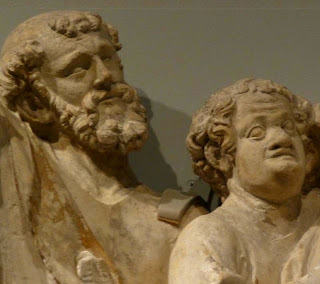


















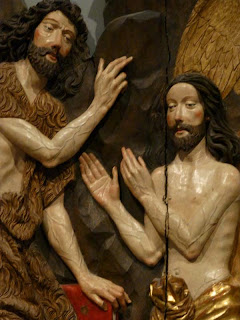





























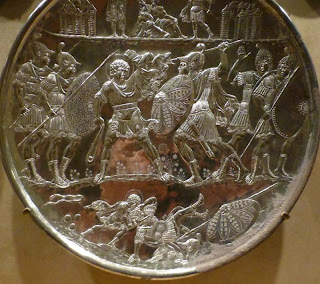
















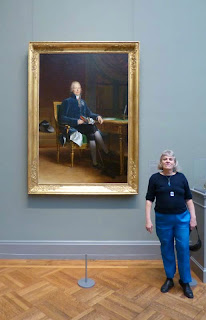





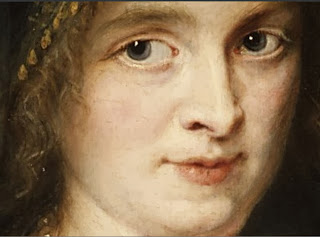





























0 Comments:
Post a Comment
<< Home